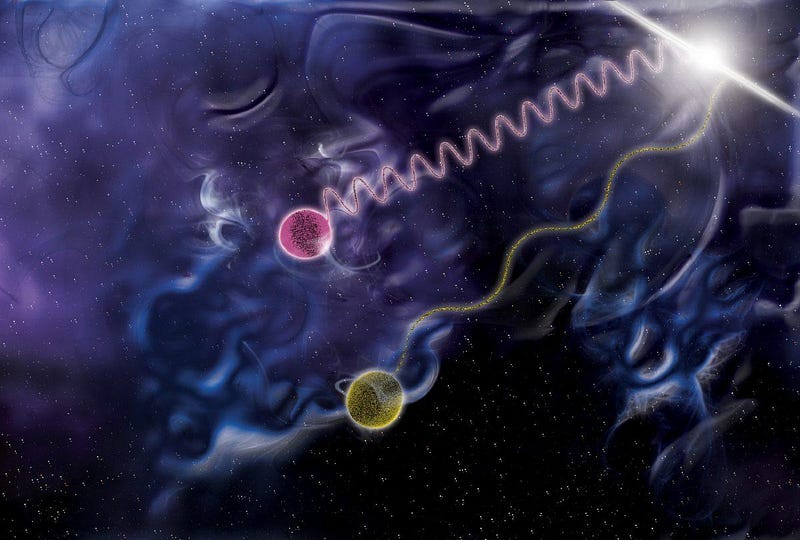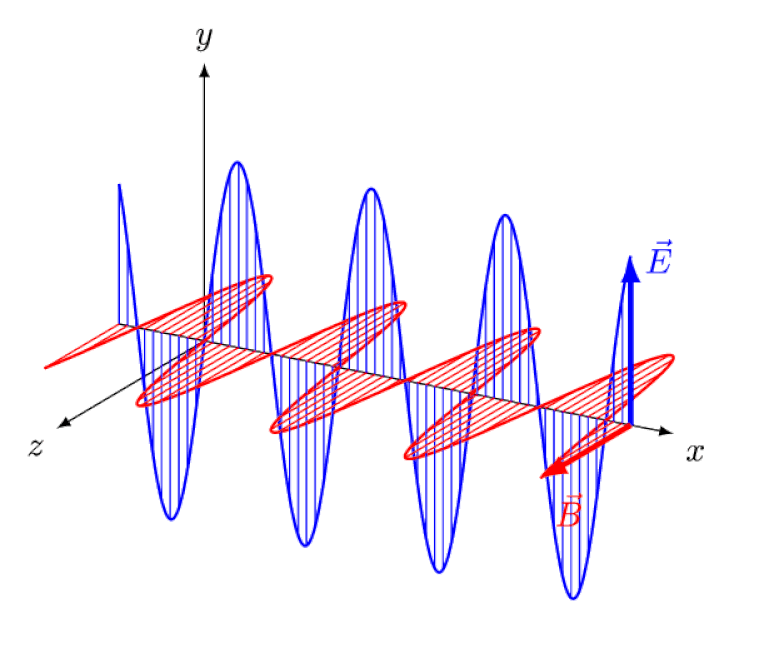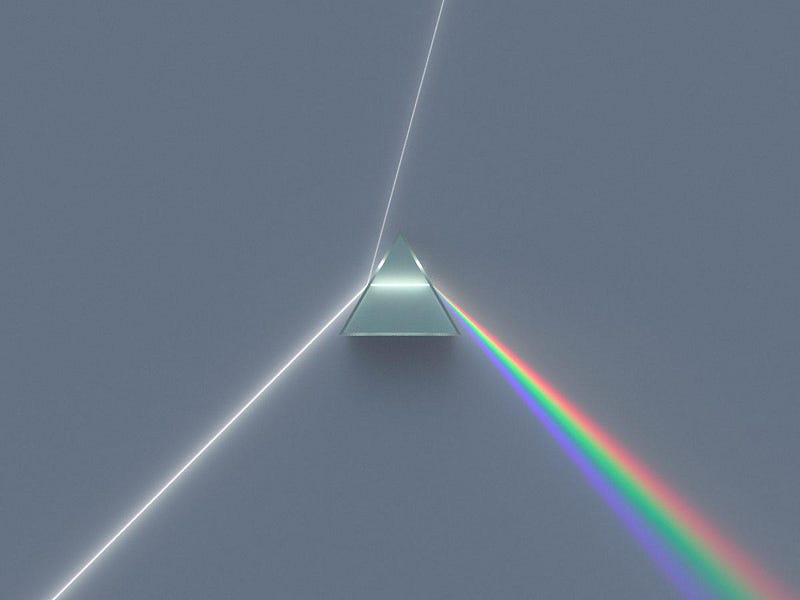Ask Ethan: Can Gamma-Ray Jets Really Travel Faster Than The Speed Of Light?

A recent headline claimed they could. But if gamma-rays are just a form of light, don’t they have to travel at light-speed?
There’s an ultimate speed limit in the Universe: the speed of light in a vacuum, c. If you don’t have any mass — whether you’re a light wave (a photon), a gluon, or even a gravitational wave — that’s the speed you must move at when you pass through a vacuum, while if you have mass, you can only move slower than c. So why, then, was there a recent story claiming that gamma-ray jets, where gamma-rays themselves are a high-energy form of light, can travel faster-than-light? That’s what Dr. Jeff Landrum wants to know, asking:
What gives? Is it really possible for gamma-rays to exceed the speed of light and thereby “reverse” time? Is the time reversal just a theoretical claim that allows these hypothetical super-light speed particles to conform with Relativity or is there empirical evidence of this phenomenon?
Let’s begin by looking at the basic physics governing the Universe.

Light comes in a wide variety of wavelengths, frequencies, and energies. Although the energy inherent to light is quantized into discrete energy packets (a.k.a., photons), there are some properties shared by all forms of light.
- Light of any wavelength, from picometer-wavelength gamma-rays to radio waves more than a trillion times longer, all move at the speed of light in a vacuum.
- The frequency of any photon is equal to the speed of light divided by the wavelength: the larger the wavelength, the shorter the frequency; the shorter the wavelength, the higher the frequency.
- The energy inherent to a photon is directly proportional to frequency: the highest-frequency/shortest-wavelength light is the most energetic, while the lowest-frequency/longest-wavelength light is the least energetic.
As soon as you leave a vacuum, however, light of different wavelengths will behave very differently.

Light, you have to remember, is an electromagnetic wave. When we talk about the wavelength of light, we’re talking about the distance between every two “nodes” in the wave-like pattern that its in-phase, oscillating electric and magnetic fields create.
When you pass light through a medium, however, all of a sudden there are charged particles located in every direction: particles that create their own electric (and possibly magnetic) fields. When the light passes through them, its electric and magnetic fields interact with the particles in the medium, and the light is forced to move at a slower speed: the speed of light in that particular medium.
What actually happens, though, that you might not expect, is that the amount that light slows down by depends on the light’s wavelength.

Why does this occur? Why do longer-wavelength (redder) photons bend less (and therefore travel faster) when they travel through a medium compared to shorter-wavelength (bluer) photons, which bend by greater amounts and therefore travel slower?
Any medium, remember, is made of up atoms, which in turn are made up of nuclei and electrons. When you apply an electric or a magnetic field to a medium, that medium itself will respond to the field: the medium gets polarized. This happens for all wavelengths of light. For longer wavelengths, however, the changes in the medium are slower; there are fewer cycles-per-second of the electromagnetic wave. Because electromagnetism always resists changes to electric and magnetic fields, the fields that change faster (corresponding to photons with shorter wavelengths, higher frequencies and greater energies) will be more effectively resisted by the medium light travels through.

This is the only “trick” we know of to cause light to move at a speed slower than the speed of light in a vacuum: to pass it through a medium. When we do that, the shortest-wavelength light — which is the most energetic — slows down by the greatest amount relative to longer-wavelength, lower-energy light. If we shone light of any frequency we chose through any medium at all, the gamma-rays, if any are generated, should travel the most slowly of all the different forms of light.
Which is why this headline is so puzzling: how could gamma-ray jets move faster than light? If we take a look at the scientific paper itself (free preprint available here), we can see there’s another component that helps clear the story up: this radiation is not moving faster than c, the speed of light in a vacuum, but v, the speed of light in the particle-filled medium surrounding the source of these gamma rays.

When you have a massive particle moving through the vacuum of space, it must always move at a speed that’s slower than c, the speed of light in a vacuum. However, if that particle then enters a medium where the speed of light is now v, which is less than c, it’s possible that the particle’s speed will suddenly now be greater than the speed of light in that medium.
When this occurs, the particle, from its interactions with the medium, will produce a special type of radiation: blue/ultraviolet light known as Čerenkov radiation. Particles may be forbidden from traveling faster than the speed of light in a vacuum under all conditions, but nothing prevents them from traveling faster than light in a medium.

What the new study is referring to is the fact that we have many different types of high-energy astrophysical phenomena that all appear to have the same general setup: extremely high-energy photons wind up getting emitted from a violent event in space in a matter-rich environment. This applies to long/intermediate gamma-ray bursts, short-period gamma-ray bursts, and X-ray flares as well.
What the researchers did was introduce a new, simple model that would explain the bizarre properties seen in pulsing gamma-ray bursts. They model the gamma-ray emissions as originating from a jet of fast-moving particles, which is consistent with what we know. But they then introduce a fast-moving impactor wave that runs into this expanding jet, and as the density (and other properties) of the medium changes, that wave then accelerates from moving slower-than-light to moving faster-than-light in that medium.

The thing is, when particles move through a medium, whether faster than light or slower than light, they are going to emit radiation either way. If you move faster than light, you produce both Čerenkov and collisional radiation. If you move slower than light, you produce Compton radiation (electron/photon scattering) or synchrotron shock radiation when you move slower than light.
If you do both, which means you move slower than light through the medium for one part of the journey and faster than light through the medium for another part of the journey, you should see two sets of light-curve features for the gamma-rays that arrive on Earth.
- The slower-than-light radiation should exhibit a time-forward signal: where events that happen earlier arrive earlier, and ones that happened later arrive later. The radiation travels faster than the signal.
- But the faster-than-light radiation should produce a time-reversed signal: where the events that happen later arrive earlier, and the events that happen earlier arrive later. The signal travels faster than the radiation.
Look at the animation below to see why this is.

Here, you can see a particle moving faster than light in a medium. The particle interacts with the medium, producing light signals at every point, which propagate spherically outwards from wherever the particle is located at that instant. But even though the light moves at the speed of light, the particle can move faster because we’re in a medium. The light that you detect, along the wavefronts shown in the final frame, is always behind the particle.
This means the signals that arrive first will be the last ones to be emitted, and the ones to arrive last were the first ones emitted: exactly the opposite of what our conventional experience is. If it were a fist headed to your face instead of a particle, first you’d feel the impact, and then you’d see the fist right in front of you, rapidly moving away from you. This is only possible in a medium. In a vacuum, the speed of light always wins every race.

Gamma-ray bursts consist of multiple pulses, and look like spikes that rise quickly and then fall off a little more slowly. Those pulses are joined by extra, smaller signals known as residuals, and show a lot of complexity. However, a detailed examination shows that the pulse residuals are not independent, but are linked to one another: some have residuals that are the time-reversed residuals of other pulses.
This is the big phenomenon that the new model put forth by Jon Hakkila and Robert Nemiroff is attempting to explain. The big deal isn’t that anything is going faster than light in a vacuum; it isn’t. The big deal is that this observed, otherwise inexplicable phenomena might have a simple astrophysical cause: a slower-than-light jet (in a medium) going superluminal (in that medium).
The pulses originating from those two phases have overlapping arrival times, and disentangling that is how we can see this reflection-like behavior in the signal. It might not be the final answer, but it’s the best explanation for this otherwise unexplained phenomenon that humanity’s hit upon so far.
Send in your Ask Ethan questions to startswithabang at gmail dot com!
Ethan Siegel is the author of Beyond the Galaxy and Treknology. You can pre-order his third book, currently in development: the Encyclopaedia Cosmologica.




